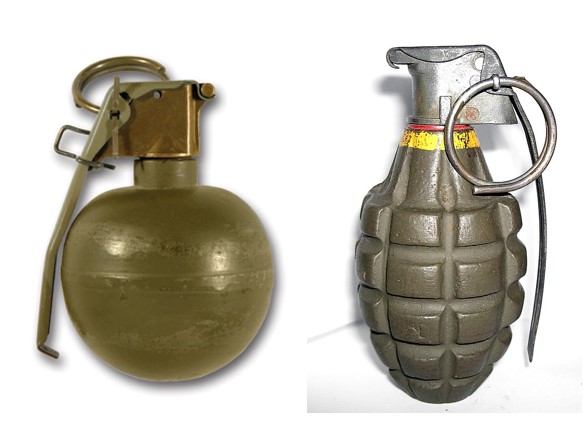
I learned this today. A hand grenade works because the removal of the lever starts a series of steps that ends with an explosion.
There are many different types of grenade. I am going to look at the fragmentation grenade. Most of us imagine the Mk 2 grenade when we think of a hand grenade. That is the one on the right in the picture for this post. However, the Mk 2 grenade was withdrawn during the 1960s and the last one was used in 1969. They were replaced by the Mk 33 series. The picture on the left at the start of this post is the Mk 67 grenade that is in use currently. The Mk 67 is the size of a baseball and an average soldier can throw it about 30 meters. It weighs 400 grams and costs about $45.
So, how does a hand grenade work? The Mk 67 has a safety pin so that the lever cannot be released accidentally. The soldier holds the lever down with the thumb and pulls out the safety pin. This makes the grenade live and ready for throwing. The lever is spring-loaded and springs off as soon as the soldier releases their thumb.
The spring that fires off the lever releases a striker that falls on the primer. This ignites the primer, creating a spark. This spark ignites a slow burning fuse. The Mk 67 grenade is set with a 4 to 5 second fuse. When the fuse has burned to the end, it ignites the detonator. The detonator is usually a capsule filled with combustible material. The explosion in the detonator ignites the explosive material in the grenade, which is usually flaked TNT. This explosion blows the grenade to pieces and sends pieces of the metal shell flying in every direction at 914 meters per second. Some grenades also have other pieces of metal and wire built into them to increase the damage. The general danger zone for a hand grenade is about 20 meters from the grenade. About 50% of exposed people become casualties within 15 meters.
Incendiary grenades were first used in the Byzantine Empire in about 717, but these appear to have been bombs that exploded on impact, rather than being timed. The invention of gunpowder in China led to the invention of rockets and thrown bombs. In about 1000 AD, they filled ceramic containers with gunpowder and used fuses. These became known as “sky-shaking thunder”. They were generally too big to be thrown by hand and are more akin to delayed bombs.
Grenades came to Europe in 1467 and they were used in besieging. They were still too big to be thrown by hand. It is possible that they were small enough to throw by the early 17th century and a special division in the army called grenadiers appeared in France in 1667. They specialized in fighting and using grenades. (Incidentally, the word “grenade” comes from French and it means pomegranate. This is what the grenades were said to resemble.) Grenades in this era were very unreliable and had unstable fuses.
A type of grenade with fins was used during the American Civil War. The fins angled the grenade so it hit the ground nose first, igniting a pressure cap and starting the explosion. There were also spherical grenades, but they weighed 2.7 kg.
Grenades died out of fashion for a while, but they came back in during the era of trench warfare. Grenades were used in the Japanese Russian war of 1904 to 1905 and then a lot of homemade grenades were used during the start of World War 1. Troops would fill a soda can with stones, gunpowder, a fuse, and throw it into the enemy trench.
The first safe to use hand grenade was the Mills bomb invented in 1915. It had a triggering pin and the notched surface that became synonymous with grenades during World War 2. This was to aid grip. 75 million Mills bombs were used during World War 1. At first, the grenade had a delay of seven seconds, but that was enough time for the enemy to throw it back, so the time was reduced to four or five seconds. The Mills bomb had some other changes and it was used by the British Armed Forces until 1972.
If someone throws a grenade at you, your best bet, according to experiments, is to dive to the ground and point your feet towards the explosion. This makes you a smaller target and your feet will take the explosion if it reaches you. You don’t have any vital organs in your feet. Your chances of being hit by a piece of shrapnel are about 1% if you can get low enough and about 4.5 meters away. You most likely would not be able to throw the grenade back as it would have used up at least three seconds of its fuse in the flight to you.
So, a grenade explodes because the trigger spring starts a delayed use that causes the grenade to explode about 5 seconds later. And this is what I learned today.
Photos By http://www.af.mil/news/airman/0106/abdefense.shtml, Public Domain, https://commons.wikimedia.org/w/index.php?curid=2352926
http://www.af.mil/news/airman/0106/abdefense.shtml, Public Domain, https://commons.wikimedia.org/w/index.php?curid=2352926
Sources:
https://en.wikipedia.org/wiki/Grenade
https://en.wikipedia.org/wiki/Grenadier
https://en.wikipedia.org/wiki/Mk_2_grenade
https://www.thoughtco.com/history-of-the-hand-grenade-1991668
https://science.howstuffworks.com/grenade2.htm
https://en.wikipedia.org/wiki/M67_grenade
http://www.madehow.com/Volume-7/Grenade.html
https://www.sciencealert.com/watch-how-to-survive-a-grenade-blast-according-to-science
